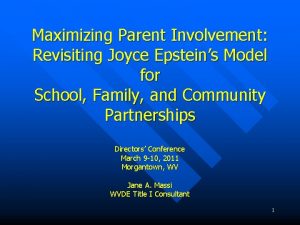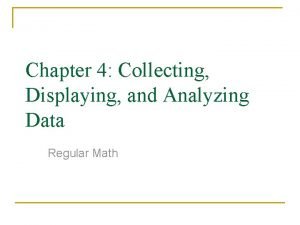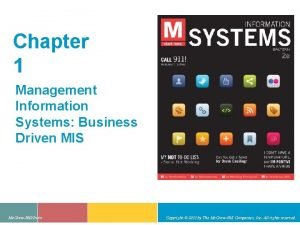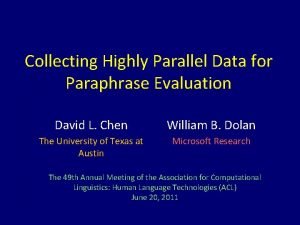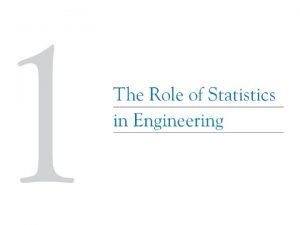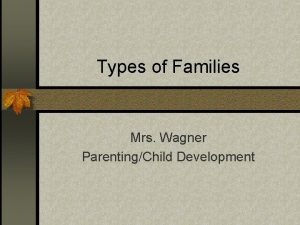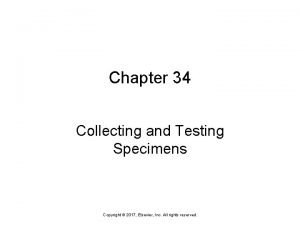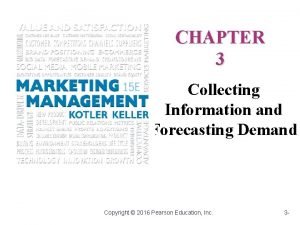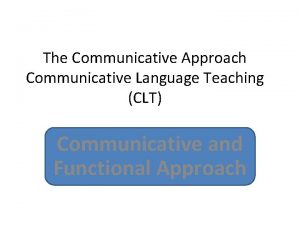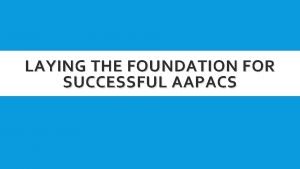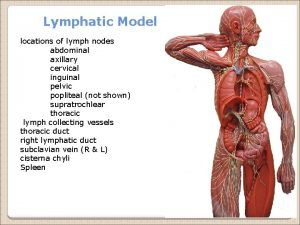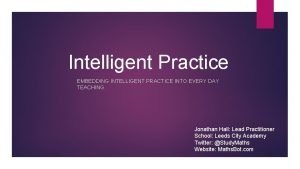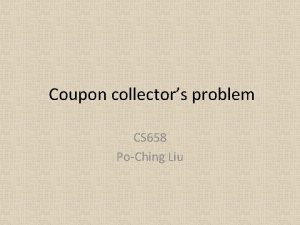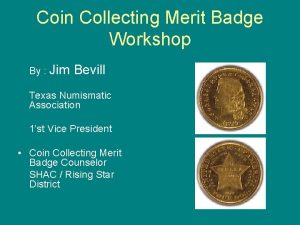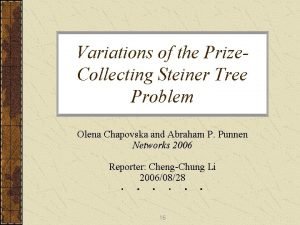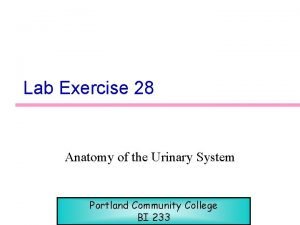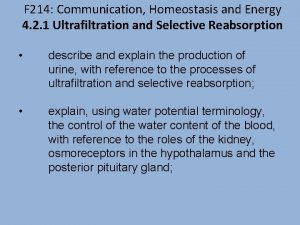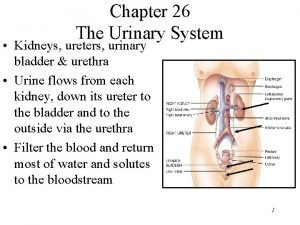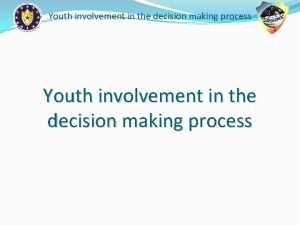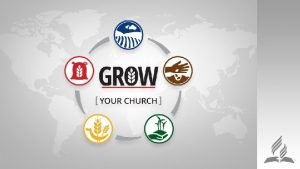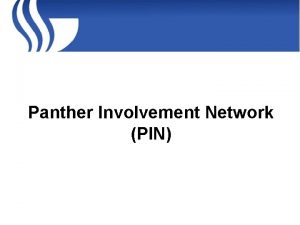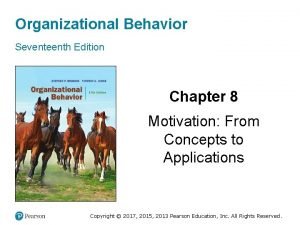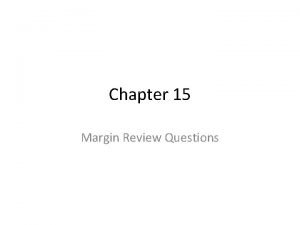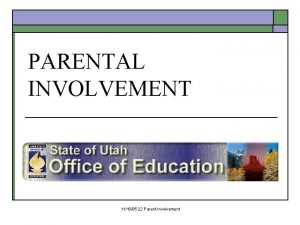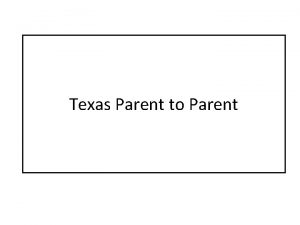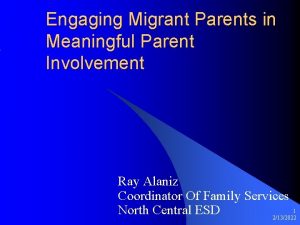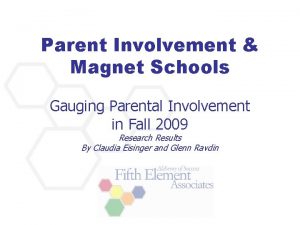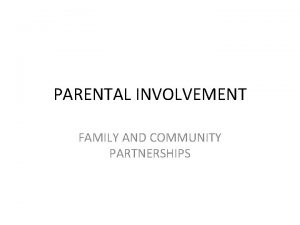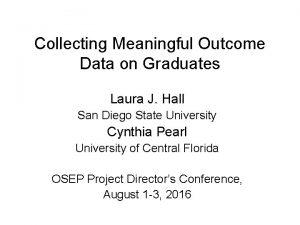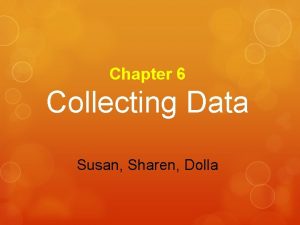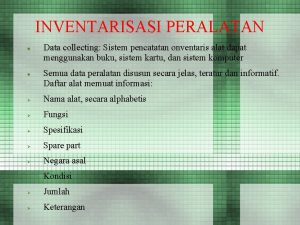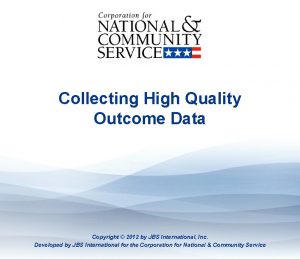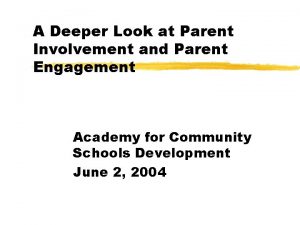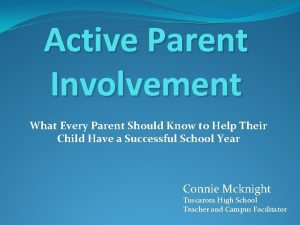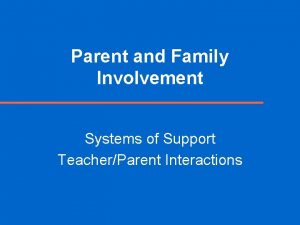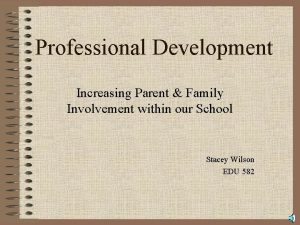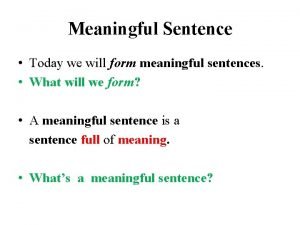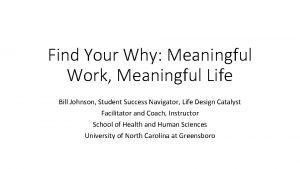Collecting Meaningful Parent and Family Involvement Data You

















































- Slides: 49

Collecting Meaningful Parent and Family Involvement Data You Can Use Amy Bitterman, IDEA Data Center Hadley Moore, IDEA Data Center Carol Seay, Georgia Department of Education 2019 OSEP LEADERSHIP CONFERENCE

2019 OSEP Leadership Conference DISCLAIMER: The contents of this presentation were developed by the presenters for the 2019 OSEP Leadership Conference. However, these contents do not necessarily represent the policy of the Department of Education, and you should not assume endorsement by the Federal Government. (Authority: 20 U. S. C. 1221 e-3 and 3474) 2

What Will We Do in Today’s Session? • Present an overview of State Performance Plan (SPP)/Annual Performance Report (APR) Indicators B 8 and C 4 • Describe approaches for measuring and improving the representativeness, or meaningfulness, of parent and family involvement data • Explore strategies for using parent and family involvement data, beyond the requirements of the indicators 3 2019 OSEP LEADERSHIP CONFERENCE

The Parent and Family APR Indicators • Indicator B 8: The percent of parents with a child receiving special education services who report that schools facilitated parent involvement as a means of improving services and results for children with disabilities • Indicator C 4: The percent of families participating in Part C who report that early intervention services have helped the family A. Know their rights B. Effectively communicate their children’s needs C. Help their children develop and learn 4 2019 OSEP LEADERSHIP CONFERENCE

What Are States Doing? All states used surveys • Part B – 48% used state-developed surveys and 39% used the National Center for Special Education Accountability Monitoring (NCSEAM) survey • Part C – 46% used the Early Childhood Outcomes Family Outcomes Survey, 32% used the NCSEAM survey, and 21% used state-developed surveys Sources: 2017 Part B and Part C FFY 2015 SPP/APR Indicator Analysis Booklet and IDC’s survey of states 5 2019 OSEP LEADERSHIP CONFERENCE

What Are States Doing in Part B? • 53% of states used sampling • About a third of the states had the districts or schools distribute the surveys • Most states administered the survey via paper and web Source: IDC’s survey of states 6 2019 OSEP LEADERSHIP CONFERENCE

What Are States Doing in Part B? (cont. ) • A third of the states distributed notifications alerting parents to the upcoming survey • Field periods ranged from 6 weeks to 9 months • About half of the states sent reminders to parents who had not completed the survey • Many states’ response rates were below 30% Source: IDC’s survey of states 7 2019 OSEP LEADERSHIP CONFERENCE

Parent Survey in Georgia • Currently in the 3 rd year of an online survey Available to all families of children with disabilities 10 questions plus demographic data questions 6 point Likert Scale Local education agencies (LEAs) receive an overall percentage measuring parental involvement • The “power” of the data is the availability of real time school-level data • • • Special Education Dashboard • Data is available to special education directors daily, January – May • School-level data 8 2019 OSEP LEADERSHIP CONFERENCE

Parent Survey Application, Special Education Dashboard When the survey is open this updates nightly 9 2019 OSEP LEADERSHIP CONFERENCE

Parent Survey – Downloadable Data • Demographic data • Redacted from the download data to avoid personally identifiable information (PII) • School Level • Participation by school • Updated nightly • By question – Strongly agree…. strongly disagree • Real-time data to answer questions • What schools had/have high participation? Why? • What schools had/have parents who report that schools encourage their involvement? • Where is work needed? • Examine responses question by question 10 2019 OSEP LEADERSHIP CONFERENCE

Previous Survey Georgia’s old survey, paper with an online option • Sampling • Some smaller LEAs were on a 5 -year cycle • Not all parents were given the opportunity to participate; some never had opportunity • Far fewer surveys completed • Results for LEAs • • • 11 A single percentage Ex. : 49% Not useful – LEAs only looked to see if they met the target Results were never shared with school administrators Results were not available by school; a single percentage was meaningless 2019 OSEP LEADERSHIP CONFERENCE

New Survey LEAs continue to receive an overall percentage measuring parental involvement and this is compared to the target – Indicator 8 data • Example – FY 18 Georgia’s target was 69% • If an LEA’s overall percentage was at or above 69%, the LEA met the target • The survey measures parental involvement data by calculating the mean for each parent based on his or her responses to the 10 questions • Parents whose responses yield a mean of 5 are included in the numerator; all parents responding are included in the denominator 12 2019 OSEP LEADERSHIP CONFERENCE

Calculating the Percentage Parent 1 responses: Q 1: Very strongly agree; 6 Q 2: Strongly agree; 5 Q 3: Very strongly agree; 6 Q 4: Agree; 4 Q 5: Strongly agree; 5 Q 6: Very strongly agree; 6 Q 7: Agree; 4 Q 8: Disagree; 3 Q 9: Very strongly agree; 6 Q 10: Very strongly agree; 6 13 Total points for Parent 1: 51 10 questions; 10/51 = 5. 1 This parent has a mean of ≥ 5 and will be included when calculating parental involvement percentage 2019 OSEP LEADERSHIP CONFERENCE

New Survey In addition to an overall LEA percentage, LEAs receive • Responses by disability area • Responses by race/ethnicity • Responses by grade band • An item ranking – highest to lowest ranked items Real benefit is school-level data 14 2019 OSEP LEADERSHIP CONFERENCE

Measuring and Improving Representativeness of Parent and Family Involvement Data “Representativeness” is the extent to which the demographics of the children whose parents participated in data collection activities are representative of the demographics of all children receiving special education/early intervention services in the state 15 2019 OSEP LEADERSHIP CONFERENCE

Why Is Representativeness Important? • Representativeness affects the meaningfulness of your data • If your data are not representative, they will not paint an accurate picture of the nature and level of parent and family involvement in your state 16 2019 OSEP LEADERSHIP CONFERENCE

Preparing to Collect Representative Data How states administer surveys can affect data quality – especially response rates and representativeness • Instrument design • Sampling • Survey mode and distribution method • Access to or collection of demographic data • Tracking responses 17 2019 OSEP LEADERSHIP CONFERENCE

Measuring Representativeness: What Have States Been Doing? States commonly assessed representativeness by comparing the characteristics of the children whose parents responded to the characteristics of the entire state population of special education or early intervention children Source: 2017 Part B FFY 2015 SPP/APR Indicator Analysis Booklet and IDC’s survey of states Two or More Races 0% 2% 82% White Native Hawaiian or Other Pacific Islander 48% 0% 1% 16% Black or African American Asian 38% 0% 2% American Indian or Alaska Native 0% 1% Hispanic/ Latino 2% 10% 0% 10% 20% 30% 40% 50% 60% 70% 80% 90% 100% Students whose parents responded 18 All students with disabilities 2019 OSEP LEADERSHIP CONFERENCE

How Can States Assess Representativeness? • Compare the characteristics of children whose parents complete the survey with those of all children with disabilities or compare the characteristics of children of responders to children of nonresponders • Examine multiple characteristics – child’s race/ethnicity, sex, disability, age, geographic location • Obtain survey responses from a sample of parents who initially did not respond to see if the way they respond to the survey differs from the responses you already have 19 2019 OSEP LEADERSHIP CONFERENCE

How Can States Assess Representativeness? (cont. ) • No one threshold for determining whether data are representative • Tools for calculating representativeness • The National Post-School Outcomes Center (NPSO) Response Calculator uses a threshold of ± 3 percent in observed data • The Early Childhood Technical Assistance Center (ECTA) Response Rate and Representativeness Calculator uses tests of statistically significant differences to determine representativeness 20 2019 OSEP LEADERSHIP CONFERENCE

How Can States Improve Representativeness During Data Collection? • Conduct periodic checks for representativeness • Send additional reminders to parents who have the specific characteristics that are underrepresented • Enlist support from Parent Centers or other key stakeholder groups to encourage parents from underrepresented groups to respond • Call parents who started but did not complete the survey to encourage them to respond 21 2019 OSEP LEADERSHIP CONFERENCE

How Can States Improve Representativeness After Data Collection and in Future Data Collections? • Weight data to account for nonrepresentative data • In the future, include larger subsamples of parents from underrepresented groups (called “oversampling”) • Work with Parent Centers and other stakeholders with connections to underrepresented groups of families to plan activities to improve representativeness in the next data collection 22 2019 OSEP LEADERSHIP CONFERENCE

How Georgia Measures and Improves Representativeness 2019 OSEP LEADERSHIP CONFERENCE 23

GA FY 18 Representativeness – Disability Area FY 18 Parent Survey, Representativeness by Disability Area 40. 0% 35. 0% 30. 0% 25. 0% 20. 0% 15. 0% 10. 0% 5. 0% 0. 0% 24 35. 0% 27. 5% 15. 4% 11. 5% 10. 2% 11. 7% 14. 8% 9. 7% 5. 3% 5. 0% 7. 5% 7. 8% 0. 5% 0. 4% 14. 7% 13. 6% FY 18: Percentage of Responses by Disability Area of Children whose Parents Responded FY 18: % of Students by Disability Area 2019 OSEP LEADERSHIP CONFERENCE

GA FY 18 Representativeness – Race/ethnicity Indicator 8: FY 18 Parent Survey 60. 0% 53. 8% 50. 0% 40. 5% 39. 4% 20. 0% 14. 3% 10. 6% 10. 0% 2. 0% 0. 5% 0. 2% 0. 0% White 25 FY 18: Percentage of Responses by Race/Ethnicity of Children whose Parents Responded FY 18: Student Demographics 27. 8% 30. 0% Black Hispanic Asian or Pacific Islander 3. 8% 3. 5% 1. 4% 0. 0% American Mulit-racial Unknown Indian or Alaska Native 2019 OSEP LEADERSHIP CONFERENCE

Addressing Representativeness • Important to note that Georgia offers all families the opportunity to participate in the survey; surveys are not distributed to select families • Increase overall participation • Share results with district and school leaders and teachers and enlist support – real time (during the survey open period) and final results • Publicize the survey – newsletters, emails, website • Provide technology at meetings, conferences, events • Analyze real-time data • State encourages special education directors to examine their data throughout the survey period to address representativeness 26 2019 OSEP LEADERSHIP CONFERENCE

Point-in-Time Data Number of Completed Parent Surveys, Sample LEA 120 109 100 80 66 60 43 40 20 18 10 40 36 30 13 3 0 Town High City Middle School 27 Country East North West High Elementary School South Middle School Happy Sunny Cloudy Elementary School 2019 OSEP LEADERSHIP CONFERENCE

Parent Mentor Partnership (PMP) The Georgia Parent Mentor Partnership is parents and professionals working together to improve outcomes for students with disabilities by enhancing communication and collaboration between families, educators and the community. • Georgia is proud of the work we are doing to engage families • Parent Mentors play a key role in increasing participation • Georgia is working to give families a voice and encourage teaming with schools to improve outcomes for children 28 2019 OSEP LEADERSHIP CONFERENCE

Discussion: Representativeness • How have you seen states examine the representativeness of parent and family involvement data? • What strategies have states used to improve representativeness? • What works well and what doesn’t work? 29 2019 OSEP LEADERSHIP CONFERENCE

Using Parent and Family Involvement Data, Beyond the Indicators: Let's explore the “why” and the “how” of using parent and family involvement data beyond the indicators! 30 2019 OSEP LEADERSHIP CONFERENCE

Make the Most of Parent and Family Involvement Data • Why? • • Ensure you are providing high-quality services Promote accountability Identify and prioritize needs for improvement Create and support family engagement initiatives • How? • • • 31 Go beyond the indicator Add qualitative findings Involve stakeholders Combine with other data Share findings 2019 OSEP LEADERSHIP CONFERENCE

Go Beyond the Indicator to Make Meaning • Generate descriptive statistics • Compare performance to investigate patterns or differences across • • Districts and programs Years Child characteristics Survey items • Explore hypotheses • Link back to questions you want answered 32 2019 OSEP LEADERSHIP CONFERENCE

Add Qualitative Findings to Provide Depth • Open-ended items on a Parent or Family Involvement survey are an example of qualitative data that you might already be collecting • Inclusion of qualitative findings can provide greater understanding of • Factors associated with parent or family involvement • Parent or family perceptions • Barriers to achieving greater parent or family involvement 33 2019 OSEP LEADERSHIP CONFERENCE

Involve Stakeholders to Gain Insight • Stakeholders can help you • • Quickly identify patterns Understand the meaning behind certain findings Explore different hypotheses Feel confident you understand the true meaning of your data • And, continue to involve stakeholders in • Decisionmaking processes • Developing overall program priorities and improvement strategies 34 2019 OSEP LEADERSHIP CONFERENCE

Combine With Other Data • Demographic data • Title I Parent and Family Engagement data • State Systemic Improvement Plan (SSIP) data • Child outcomes data • Graduation, drop out, and academic achievement data 35 2019 OSEP LEADERSHIP CONFERENCE

Share Findings With Various Audiences • Sharing findings is critical to make the most of your efforts and effect change • Considerations for sharing findings with families include • Share information that is highly relevant to them • Focus on plans for improvement • Ensure communications are accessible to all families 36 2019 OSEP LEADERSHIP CONFERENCE

Share Findings With Various Audiences (cont. ) • Mechanisms for sharing with educators • • 37 Regular communications, such as newsletters or emails Committee meetings Internal local dashboards for districts Statewide meetings (have districts with improved or high response rates share successful strategies) 2019 OSEP LEADERSHIP CONFERENCE

How Georgia Makes the Most of Data 2019 OSEP LEADERSHIP CONFERENCE 38

Using the Parent Survey Data in Georgia State Level • Family Engagement and Dispute Resolution Unit at the GADOE • Special Education Family Engagement staff are part of this unit • Coupling family engagement and the ‘Help Desk’ work with the investigation of state complaints is intentional • Georgia is exploring ways to correlate the Indicator 8 data with the dispute resolution data • Data is useful in other ways • State staff leads the work for using Parent Survey Data at the LEA and School Level 39 2019 OSEP LEADERSHIP CONFERENCE

How Georgia Uses the Data • More than federal reporting • The useful data • School level • Share with school leaders • Share with teachers • Question-by-question analysis is possible • Target efforts to schools and specific areas of need • Ultimate goal • Know and understand where and why families believe they are considered to be a true partner in improving outcomes for their child(ren) • Address the issues at the schools where families do not believe they are considered to be a partner 40 2019 OSEP LEADERSHIP CONFERENCE

Example 1 Question: The school provides information on agencies that can assist my child in grade level transition and/or transitions to post-school settings. In one LEA: • 32. 8% of the respondents disagreed with this at some level District response: After analyzing their data, an LEA planned a Transition Fair to address this need 41 2019 OSEP LEADERSHIP CONFERENCE

Example 2 Question: The school communicates regularly with me regarding my child’s progress on IEP goals. • School A: 91. 3% expressed some level of agreement with this statement • School B: 62. 7% expressed some level of agreement with this statement Where should valuable time and effort be spent? School B Be careful to not base decisions on small responses. 42 2019 OSEP LEADERSHIP CONFERENCE

Example 3 Question: I am considered an equal partner with teachers and other professionals in planning and making decisions about my child’s program. • School C: 88. 5% based on 26 responses • School D: 0%, based on 1 response • School E: 100. 0% based on 2 responses District response: Address survey participation at schools D and E, share results with teachers and staff; non-participation is data too • Celebrate school C 43 2019 OSEP LEADERSHIP CONFERENCE

Example 4 • Teachers ensure that I have fully understood the Procedural Safeguards [federal rules that protect the rights of parents] and my options if I disagree with a decision by the school. • School A: 88% with some level of agreement • School B: 68% with some level of agreement • At the IEP meeting, we discussed accommodations and modifications that my child would need. • School A: 92% with some level of agreement • School B: 66% with some level of agreement District response: provide professional learning to teachers/staff at School B regarding provision of Procedural Safeguards and how to conduct an IEP meeting 44 2019 OSEP LEADERSHIP CONFERENCE

Discussion: Making the Most of Your Data • What ideas do you have for new ways to combine parent and family involvement data with other existing data? • How have you seen states use parent and family involvement data to make improvements to programs and services for children with disabilities and their families? • What ideas do you have for new ways that states can use parent and family involvement data to inform action? 45 2019 OSEP LEADERSHIP CONFERENCE

IDC Resources and Opportunities for TA • Parent Involvement Toolkit – Making the Most of Parent Involvement Data: Improving Quality and Enhancing Understanding • Part C IDEA Data Process Toolkit and Part B IDEA Data Processes Toolkit • Peer-to-Peer Exchanges for Indicators C 4 and B 8 46 2019 OSEP LEADERSHIP CONFERENCE

Contact Us Amy Bitterman Amy. Bitterman@Westat. com Hadley Moore Hadley. Moore@Westat. com Carol Seay cseay@doe. k 12. ga. us 47 2019 OSEP LEADERSHIP CONFERENCE

For More Information Visit the IDC website http: //ideadata. org/ Follow us on Twitter https: //twitter. com/ideadatacenter Follow us on Linked. In http: //www. linkedin. com/company/idea-data-center 48 2019 OSEP LEADERSHIP CONFERENCE

2019 OSEP Leadership Conference DISCLAIMER: The contents of this presentation were developed by the presenters for the 2019 OSEP Leadership Conference. However, these contents do not necessarily represent the policy of the Department of Education, and you should not assume endorsement by the Federal Government. (Authority: 20 U. S. C. 1221 e-3 and 3474) 49
 Joyce epstein model
Joyce epstein model Collecting and displaying data
Collecting and displaying data What is data converted into a meaningful and useful context
What is data converted into a meaningful and useful context Collecting highly parallel data for paraphrase evaluation
Collecting highly parallel data for paraphrase evaluation Samples of collecting engineering data
Samples of collecting engineering data Disadvantages of single parent family
Disadvantages of single parent family Advantages and disadvantages of nuclear family
Advantages and disadvantages of nuclear family Chapter 34 collecting and testing specimens
Chapter 34 collecting and testing specimens Collecting information and forecasting demand
Collecting information and forecasting demand Market research demand forecasting
Market research demand forecasting Binuclear family vs blended family
Binuclear family vs blended family Greek mythology chaos family tree
Greek mythology chaos family tree Commutative approach
Commutative approach Aapacs
Aapacs Regulation of tubular reabsorption
Regulation of tubular reabsorption Ductnn
Ductnn Internal naris
Internal naris Maths bot.com
Maths bot.com Coupon collecting problem
Coupon collecting problem Collecting gas over water
Collecting gas over water Lymphatic trunk
Lymphatic trunk Collecting gas over water
Collecting gas over water Physics or stamp collecting
Physics or stamp collecting Coin collecting merit badge
Coin collecting merit badge Collect gas over water
Collect gas over water Algebra dr frost
Algebra dr frost Prize collecting steiner tree
Prize collecting steiner tree Who is a collecting banker
Who is a collecting banker Tag questions we often watch tv in the afternoon
Tag questions we often watch tv in the afternoon Macula densa cells
Macula densa cells Collecting ducts
Collecting ducts Collecting duct meaning
Collecting duct meaning Where does most reabsorption occur
Where does most reabsorption occur Collecting ducts
Collecting ducts Collecting ducts
Collecting ducts Nitrogenous waste
Nitrogenous waste Kidney
Kidney Words that come to mind when you think of family
Words that come to mind when you think of family Involvement decision making
Involvement decision making Total member involvement pdf
Total member involvement pdf Panther involvement network
Panther involvement network Social work seven principles
Social work seven principles Panther involvement network
Panther involvement network Pin network gsu
Pin network gsu How can employee involvement measures motivate employees
How can employee involvement measures motivate employees Gaisce bronze award sheet
Gaisce bronze award sheet Furcation dental definition
Furcation dental definition Brazil ww2 involvement
Brazil ww2 involvement Community participation
Community participation What drove european involvement in asian commerce
What drove european involvement in asian commerce
